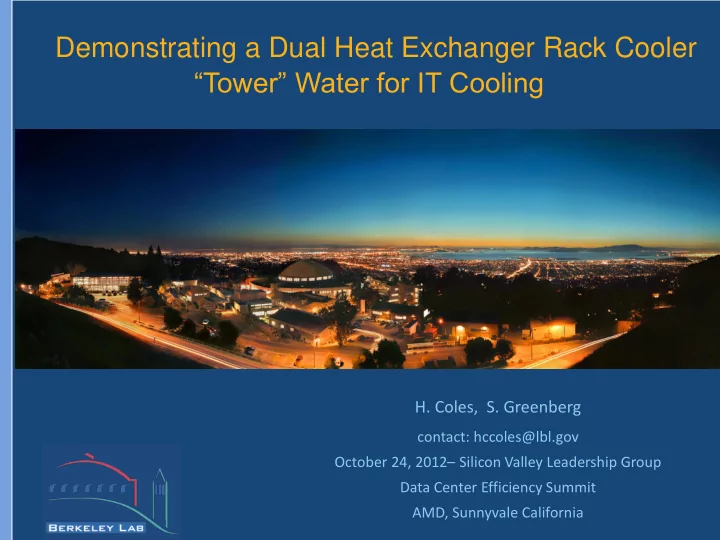

Demonstrating a Dual Heat Exchanger Rack Cooler “Tower” Water for IT Cooling H. Coles, S. Greenberg contact: hccoles@lbl.gov October 24, 2012 – Silicon Valley Leadership Group Data Center Efficiency Summit AMD, Sunnyvale California
Project Overview PI: W. F. Tschudi Researchers: Henry Coles, Steve Greenberg Sponsors: California Energy Commission (CEC) Partners: APC by Schneider Electric Synapsense LBNL Data Center – Building 50 Project Term: Concept July 2009/start July 2010-end Oct 2012 SVLG 2012 - Sunnyvale California 2
Presentation • Goal/Objectives • Background/Methods • Cooling Design Concept • Reverse Engineering – Construct Model • Forward Engineering – Calculate Results • Conclusions SVLG 2012 - Sunnyvale California 3
Project Goal/Objective Goal: Demonstrate the benefits of cooling IT equipment using high temperature water using a unique cooling unit. Objectives: • Measure performance • Develop a predictive model • Calculate Metrics SVLG 2012 - Sunnyvale California 4
Background / Methods 1. Discussed concept with APC 2. APC constructs prototype 3. Install Unit at LBNL Data Center 4. Instrument Heat Exchangers, Electrical Power and Air Temperature 5. Record Thermal/Power Performance 6. Reverse Engineer Heat Exchanger/Construct Closed Form Solution 7. Calculate Metrics/Plot Results /Draw Conclusions SVLG 2012 - Sunnyvale California 5
APC Prototype Dual Hex Cooler SVLG 2012 - Sunnyvale California 6
Demonstration Installation Cold Aisle Heat IT IT Exchanger Equipment Equipment Rack Rack Heat Exchanger APC Prototype InRow ™ Cooler Hot Aisle Air Containment Hot Aisle Curtain IT IT IT Equipment Equipment Equipment Rack Rack Rack Cold Aisle 7 SVLG 2012 - Sunnyvale California
Function Concept Cold Air Going to Cold Aisle (IT Equipment Intake) Use Chilled Water Only When Required Maximize Use of Hot Air Provides Localized WSE “Tower” Water From Hot Aisle (IT Equipment Exhaust) SVLG 2012 - Sunnyvale California 8
Data Collection Cooled Air Leaving (to server inlets) SynapSense Wireless ONICON “Btu” Meter ION Power Meter Chiller Cooled Fans Chilled Water Water Heat Exchanger Connection Tower Cooled Tower Water Water Heat Exchanger Connection Air Filter ONICON “Btu” Meter SynapSense Wireless Hot Air Entering (from server exhausts) SVLG 2012 - Sunnyvale California 9
Reverse Engineering Problem Heat Exchanger Performance Not Provided gathered data need closed form model SVLG 2012 - Sunnyvale California 10
Reverse Engineering (cont.) [DBPP warning] Fit to Hex Theory: Cross Flow, One Fluid Mixed, Other Unmixed C = mass flow rate x heat capacity 1 E = 1 – exp(-Tau * ( C max / C min )) If Cmax = Cmixed (air) Tau = 1 – exp(-N tu * ( C min / C max )) 1 E = ( C max / C min ) * (1 – exp(-Tau' * ( C min / C max ))) If Cmax = Cmixed (water) Tau' = 1 – exp(-N tu ) 1 N tu = AU / C min solve for AU q (heat transferred) = E C min (T hot in – T cold in ) calculate exiting temperatures (T hot out, T cold out ) 1 Kays, W. M. and A. L. London. 1964. C ompact Heat Exchangers, 2nd Edition. Stanford University. Page 19 SVLG 2012 - Sunnyvale California 11
Check Closed Form Solution SVLG 2012 - Sunnyvale California 12
Heat Exchanger Reverse Engineering Results SVLG 2012 - Sunnyvale California 13
Results (forward engineering) pPUE Comparison 100 cfm / kW, Server Inlet = 72ºF, Tower Water = 68ºF, Chilled Water = 45ºF 1.20 One Hex - Chilled Water 1.16 Two Hexes – Tower (max flow), 1.12 Add Chilled pPUE 1.08 Chilled Water Flow Starts 1.04 One Hex – Tower Only 1.00 26 30 34 38 42 46 50 54 58 IT Cooling (kW) SVLG 2012 - Sunnyvale California 14
Results (cont.) SVLG 2012 - Sunnyvale California 15
Compare to Chill-Off 2 Devices SVLG 2012 - Sunnyvale California 16
Conclusions • Warmer (tower/economizer) water provides 30 to 50 % cooling efficiency improvements, compared to water supplied using compressor-based (chiller) cooling. • Design minimizes compressor based cooling (individual localized economizer, lower pPUE) • Fan energy has a significant effect on efficiency at high air flow rates. • The prototype cooling unit compared favorably (20-30 percent improvement) to similar devices evaluated in a past PIER demonstration project (Chill-Off 2) SVLG 2012 - Sunnyvale California 17
End Questions? SVLG 2012 - Sunnyvale California 18
Backup Slides SVLG 2012 - Sunnyvale California 19
SVLG 2012 - Sunnyvale California 20
pPUE Comparison of 4 Configurations One or Two Heat Exchangers in Series, Tower and Chilled Water Supply Servers = 100 cfm/kW, Server Air Inlet = 72°F, Tower Water = 68°F, Chilled Water = 45°F pPUE Includes Plant Power and Cooling Unit Power Only 1.20 1.16 Case 1 : Tower Water < = 24 gpm (two heat exchangers) Chilled Water Added as Needed Case 4 : Chilled Water Only pPUE 1.12 (one heat exchanger removed) Fan Power = 68% 1.08 Case 2 : Tower Water Only <= 48 gpm Not able to (two heat exchangers) meet 1.04 Case 3 : Tower Water Only 72°F (one heat exchanger removed) Set Point Fan Power = 68% 1.00 26 28 30 32 34 36 38 40 42 44 46 48 50 52 54 56 IT Power (kW) SVLG 2012 - Sunnyvale California 21
Plant Model kW / ton vs. supplied water temperature kW/ton vs. Chilled Water Temperature (CWT) distribution pumping included 0.7 Electrical Power Needed (kW/ton) y = 0.0000051561x 3 Santa Clara CA 0.6 - 0.0008596432x 2 Year Average + 0.0327788257x 0.5 + 0.3552353121 0.4 0.3 0.2 0.1 0 40 45 50 55 60 65 70 75 80 85 90 Cooling Water Temperature (°F) Taylor Engineering SVLG 2012 - Sunnyvale California 22
COP Metric Definition COP [ kW thermal / kW elec. ] = cooling provided / power needed cooling provided (kW) = treated water cooling + chilled water cooling – APC Unit Power power needed (kW) = (kW/ton * tons) + (kW/ton * tons) + APC Unit Power APC Unit Power pCOP? using PUE and pPUE 23
Recommend
More recommend